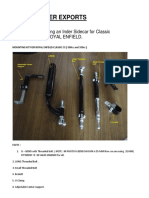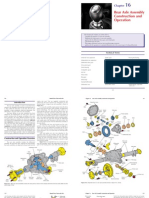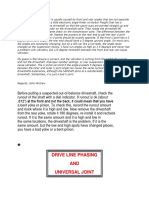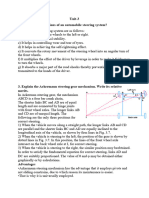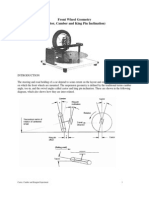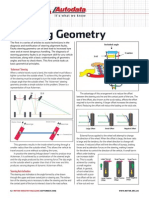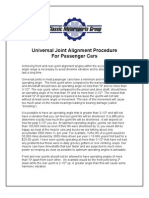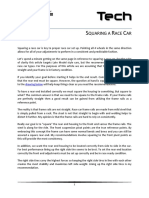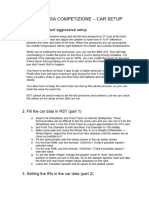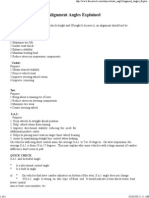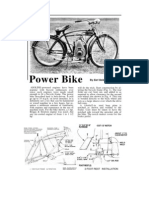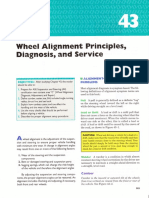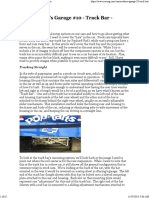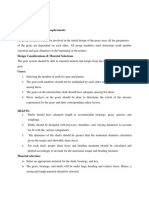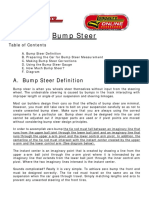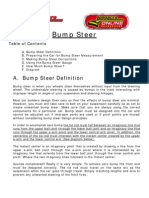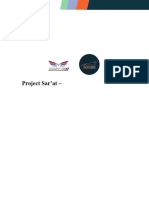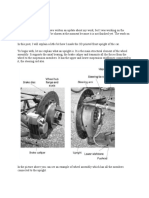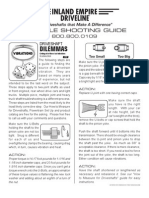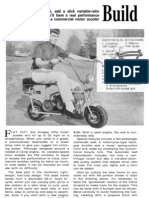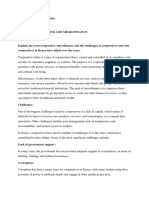Driveline Instructions 1
Driveline Instructions 1
Uploaded by
Pete Da HeatCopyright:
Available Formats
Driveline Instructions 1
Driveline Instructions 1
Uploaded by
Pete Da HeatCopyright
Available Formats
Share this document
Did you find this document useful?
Is this content inappropriate?
Copyright:
Available Formats
Driveline Instructions 1
Driveline Instructions 1
Uploaded by
Pete Da HeatCopyright:
Available Formats
Power Train Set-Up Guide
By Greg Frick of Inland Empire Driveline Service Originally published in StreetScene magazine, December 1997 Reprinted with permission of StreetScene magazine
Having a little information at the beginning of your street rod project can make setting up power train angles one of the simplest steps in the building process. Not having, or ignoring this information can turn your dream car into a nightmare. Here is what you need to know. The centerline of the crankshaft and transmission output shaft must be parallel to the centerline of the pinion shaft as shown in Figure 1. You will note that there is some distance between these parallel lines. The distance is caused by the angle of the components and their distance apart.
Planning these component angles is critical. Your task is to set the components up so their center lines are parallel and so that the angle made THROUGH the U-joints is 3degrees or less as shown in Figure 2. While it is possible to run at zero degrees through the U-joints, something more than actual zero and less than three degrees seems to run smoothest.
It will be worth the effort to set the engine and transmission in the frame and the axle under it to experiment. Fairly reliable angles can be measured from the starter motor case and of the pinion yoke. A piece of 2x4 (wood) can be cut to length to simulate the drive shaft for measuring its angle and to check for interference (or contact) with other chassis and body components. When you are satisfied that you have the proper angles in place you can mount the components. You will be married to the engine and transmission placement but must plan for adjustability at the rear axle. When the car is finished, recheck the pinion angle. If the body weight has changed the pinion angle, correct it. Leaf spring cars will need axle angle shims for adjustment. These are available at front end alignment shops or their suppliers. Now go for a ride. An angle induced vibration will be high frequency, twice engine RPM in direct drive. It may show up only on acceleration or deceleration. Adjust the pinion down to correct acceleration and up to correct deceleration vibrations, plus or minus one degree is usually enough. Before adjusting anything, make sure the U-bolts holding the driveshaft to the pinion
yoke are not overtightened. Correct torque is 17 foot pounds and no more. In following this set up routine you may find parts of the car where the drive shaft should go. While this may require some redesign, it is better to learn this before the car is complete and is difficult to correct.
A length of 2x4, or similar material, can be installed between the transmission and the rear end pinion to check angles and to determine if any chassis or body components will interfere with the drive shaft. It's a lot easier to relocate an item now than later... and it does happen!
The engine/transmission should be set in the chassis with the rear approximately 3 degrees below horizontal. A magnetic-based protractor (shown) can be used to check the angle on the block where the starter mounts (or on the starter housing itself). Since the engine/trans mounts rarely are adjustable, the rear end housing will be adjusted to set the pinion angle. (See Figure 2.)
The magnetic protractor can be used on the rear driveline yoke to set the pinion angle at the same degree as the engine/transmission, except the yoke will be 3degrees above horizontal.
Various methods are available to adjust for proper pinion angle. On a parallel leaf spring, wedge shaped shims can be added between the spring and spring pad. On triangulated 4-link, such as this, the upper and lower links can be lengthened or shortened as required.
You might also like
- Classic C5 Sidecar Fittment ManualDocument16 pagesClassic C5 Sidecar Fittment ManualJhon Eliseo Soto Sanchez100% (1)
- 2131 CH16Document13 pages2131 CH16Krishanlal GuinNo ratings yet
- Chevy Differentials: How to Rebuild the 10- and 12-BoltFrom EverandChevy Differentials: How to Rebuild the 10- and 12-BoltRating: 5 out of 5 stars5/5 (17)
- The Perfect Corner 2: A Driver's Step-by-Step Guide to Optimizing Complex Sections Through the Physics of RacingFrom EverandThe Perfect Corner 2: A Driver's Step-by-Step Guide to Optimizing Complex Sections Through the Physics of RacingNo ratings yet
- BuildingonPeople PDFDocument8 pagesBuildingonPeople PDFAsahi Cantu100% (1)
- Garden Tractor Plans PDFDocument11 pagesGarden Tractor Plans PDFLucian LeonteNo ratings yet
- Chevelle Performance Projects: 1964-1972From EverandChevelle Performance Projects: 1964-1972Rating: 4.5 out of 5 stars4.5/5 (2)
- U1 Donsbach&Traugott PDFDocument639 pagesU1 Donsbach&Traugott PDFLucas San VicenteNo ratings yet
- SM Setup Guide and Chassis Tuning TipsDocument9 pagesSM Setup Guide and Chassis Tuning TipsrendaoNo ratings yet
- Driveshaft Vibration AnalysisDocument8 pagesDriveshaft Vibration AnalysisPrasadNo ratings yet
- Affects of Alignment, Chain Tension and Tire PressureDocument2 pagesAffects of Alignment, Chain Tension and Tire PressurePrasetyo AdiNo ratings yet
- AE Unit-3Document6 pagesAE Unit-3doddi.ajith2003No ratings yet
- Castor Camber KingpinDocument7 pagesCastor Camber KingpingagalixNo ratings yet
- Steering GeometryDocument4 pagesSteering GeometryAnanya BhardwajNo ratings yet
- Universal Joint Alignment Proc 111606Document5 pagesUniversal Joint Alignment Proc 111606Slobodan GaricNo ratings yet
- Quaring A ACE AR: Drawing BelowDocument7 pagesQuaring A ACE AR: Drawing BelowHORSEAMYSAM1No ratings yet
- Assetto Corsa Competizione - Car Setup: 1. Run With Default Aggressive SetupDocument17 pagesAssetto Corsa Competizione - Car Setup: 1. Run With Default Aggressive Setupmysecondacc788No ratings yet
- Alignment Angles ExplainedDocument4 pagesAlignment Angles ExplainedAnonymous QiMB2lBCJLNo ratings yet
- Suburban Runabout Three Wheel ScooterDocument14 pagesSuburban Runabout Three Wheel ScooterJim100% (8)
- Front Suspension OverviewDocument10 pagesFront Suspension OverviewDurganshuNo ratings yet
- Drive Axle PDFDocument12 pagesDrive Axle PDFnamduong368No ratings yet
- Power BikeDocument4 pagesPower BikeGreg AnguishNo ratings yet
- Measuring and Correcting Bump Steer On A Caterham 7Document8 pagesMeasuring and Correcting Bump Steer On A Caterham 7damdy-cashNo ratings yet
- Pedal Car Construction: Chassis DesignDocument4 pagesPedal Car Construction: Chassis DesignanilbabuNo ratings yet
- Alignment: Diagnosis, ServiceDocument33 pagesAlignment: Diagnosis, Service2791957No ratings yet
- Arrow Setup GuideDocument32 pagesArrow Setup GuideDevaka Balasuriya100% (1)
- Suspension: 1) Wheelbase and TrackwidthDocument8 pagesSuspension: 1) Wheelbase and TrackwidthRaneem khaledNo ratings yet
- Ford V8 4C 1932Document89 pagesFord V8 4C 1932rukford1No ratings yet
- Commodore - S Garage #10 - Track Bar - IracingDocument4 pagesCommodore - S Garage #10 - Track Bar - IracingHitesh VashistNo ratings yet
- Gear Box Project Guide LinesDocument12 pagesGear Box Project Guide LinesteddiyfentawNo ratings yet
- Formula 1 - Race Setup GuideDocument54 pagesFormula 1 - Race Setup GuidesupernovadaveNo ratings yet
- Suzuki 4x4 - Information - Bump SteerDocument5 pagesSuzuki 4x4 - Information - Bump SteerShine And MoreNo ratings yet
- Bump Steer by Longacre RacingDocument5 pagesBump Steer by Longacre RacingFotis FotopoulosNo ratings yet
- Velo Steering 09 10Document8 pagesVelo Steering 09 10onezero111No ratings yet
- PS Ch1 - Initial Design ConsiderationsDocument13 pagesPS Ch1 - Initial Design ConsiderationsZahid AhmadNo ratings yet
- BE 4gtapered Instructions 2015Document8 pagesBE 4gtapered Instructions 2015captainobvious1904No ratings yet
- Upright DesignDocument5 pagesUpright DesignFiras HelouNo ratings yet
- Dilemmas: Trouble Shooting GuideDocument3 pagesDilemmas: Trouble Shooting GuideCosmicdancer RudraNo ratings yet
- Quick Car Setup Guide Williams Toyota FW31Document8 pagesQuick Car Setup Guide Williams Toyota FW31maferioNo ratings yet
- Camaro High Performance Suspension TuningDocument5 pagesCamaro High Performance Suspension TuningSarawoot Watechagit100% (1)
- Camber CasterDocument12 pagesCamber CasterHarsh BhaskarNo ratings yet
- SteeringDocument114 pagesSteeringanshuman sharmaNo ratings yet
- Car BibleDocument3 pagesCar BibleSoheil YadNo ratings yet
- LG # 4 Wheel AlignmentDocument57 pagesLG # 4 Wheel Alignmenttedozego9No ratings yet
- Afx Rear DiscDocument9 pagesAfx Rear Dischenriquearmani78No ratings yet
- Bicycle MinibikeDocument6 pagesBicycle MinibikeJim100% (1)
- PacoMoto HubStands Ver5 - 3Document6 pagesPacoMoto HubStands Ver5 - 3maurolucaNo ratings yet
- 4 Wheel Alignment On A Mazda MXDocument24 pages4 Wheel Alignment On A Mazda MXJam BabNo ratings yet
- Subject: Pump and Driver AlignmentDocument5 pagesSubject: Pump and Driver Alignmentmohamed elejmiNo ratings yet
- Goodyear Ackerman Steering Effect On Tyre WearDocument7 pagesGoodyear Ackerman Steering Effect On Tyre WearpvekzNo ratings yet
- Bump Steer: 1. Measure The Length of The Shock Absorber. 2. Measure The Angle of The Upper A FrameDocument2 pagesBump Steer: 1. Measure The Length of The Shock Absorber. 2. Measure The Angle of The Upper A FrameAramis SchultzNo ratings yet
- Adjusting The Brakes On A Model A FordDocument5 pagesAdjusting The Brakes On A Model A FordDavid RobinsonNo ratings yet
- A DIY'ers Definitive Guide to Building a Custom Volkswagen TrikeFrom EverandA DIY'ers Definitive Guide to Building a Custom Volkswagen TrikeNo ratings yet
- The Book of the Singer Junior - Written by an Owner-Driver for Owners and Prospective Owners of the Car - Including the 1931 SupplementFrom EverandThe Book of the Singer Junior - Written by an Owner-Driver for Owners and Prospective Owners of the Car - Including the 1931 SupplementNo ratings yet
- How to Power Tune Minis on a Small Budget: New Updated & Revised EditionFrom EverandHow to Power Tune Minis on a Small Budget: New Updated & Revised EditionNo ratings yet
- Caring for your scooter: How to maintain & service your 49cc to 125cc twist & go scooterFrom EverandCaring for your scooter: How to maintain & service your 49cc to 125cc twist & go scooterNo ratings yet
- (PN) Makmur Juali Lender SDN BHD APPLICATION FORM-1 - 240205 - 130816Document2 pages(PN) Makmur Juali Lender SDN BHD APPLICATION FORM-1 - 240205 - 130816PaviNo ratings yet
- Piping Line List: Ventech Engineers, Inc. Pasadena, Texas, P.O.Box 4261Document7 pagesPiping Line List: Ventech Engineers, Inc. Pasadena, Texas, P.O.Box 4261samer8saifNo ratings yet
- Lecture 5 - Bond Portfolio Management - IRRM - Immunization and ALMDocument31 pagesLecture 5 - Bond Portfolio Management - IRRM - Immunization and ALMNguyễn Việt LêNo ratings yet
- An Opaque Project or 22222 Auto Saved)Document21 pagesAn Opaque Project or 22222 Auto Saved)Ayen YbañezNo ratings yet
- Program Management: What Is It Really?Document22 pagesProgram Management: What Is It Really?sousousabriNo ratings yet
- Impact of Voyages, Discoveries and Renaissance On Geographical Thought - GeograpDocument19 pagesImpact of Voyages, Discoveries and Renaissance On Geographical Thought - Geograpmdsabakarim12No ratings yet
- Model Name: N32N101 Pcbno: La-1011 Date: 2001/09/01 Revision: 1.0Document46 pagesModel Name: N32N101 Pcbno: La-1011 Date: 2001/09/01 Revision: 1.0Xxvic2rxXNo ratings yet
- Guideline - Tariffs - Medical - Practitioners - 12 - Aug - 2012Document84 pagesGuideline - Tariffs - Medical - Practitioners - 12 - Aug - 2012Kasturie PillayNo ratings yet
- Os MultiprogrammingDocument15 pagesOs MultiprogrammingSunil Shekhar Nayak100% (1)
- Selected Exercises in Preparation of Question 1 On BA 6601 (Section 9) Compressive ExamDocument4 pagesSelected Exercises in Preparation of Question 1 On BA 6601 (Section 9) Compressive ExamAdam Khaleel0% (1)
- Daf 1207 FSN PDFDocument6 pagesDaf 1207 FSN PDFODUNDO JOEL OKWIRINo ratings yet
- Pending Proposals Ldu June 09Document35 pagesPending Proposals Ldu June 09Anurag GoelNo ratings yet
- Rate of Rise/Fixed Temperature Heat Detector: FeaturesDocument2 pagesRate of Rise/Fixed Temperature Heat Detector: FeaturesHazairin As-Shiddiq RahmanNo ratings yet
- Prompt EngineeringDocument12 pagesPrompt EngineeringcmarchianiNo ratings yet
- MOU With Canara Bank For Lending Various Loans To BSNL Employees 14-01-13Document10 pagesMOU With Canara Bank For Lending Various Loans To BSNL Employees 14-01-13suresh_496No ratings yet
- The Beatles Angielska PrezentacjaDocument12 pagesThe Beatles Angielska Prezentacjakk3071178No ratings yet
- Computer Science Nios Senior Secondary 330Document7 pagesComputer Science Nios Senior Secondary 330raju baiNo ratings yet
- MSDS B504Document5 pagesMSDS B504uuabduu49No ratings yet
- BSBDIV501 Unit of Competency Final Result V2Document1 pageBSBDIV501 Unit of Competency Final Result V2Agus BudionoNo ratings yet
- WIPES Clinitex Hard Surface Disinfection WipesDocument7 pagesWIPES Clinitex Hard Surface Disinfection WipesNasraldeen MohamedNo ratings yet
- Prof Ed 12Document26 pagesProf Ed 12And'z MirabuenoNo ratings yet
- Rec - Catalogo Cake Designer Walmart InfantilDocument27 pagesRec - Catalogo Cake Designer Walmart InfantildocessaciNo ratings yet
- JN0 250Document17 pagesJN0 250Horacio LopezNo ratings yet
- Commscope RZVV-65B-R4Document5 pagesCommscope RZVV-65B-R4Valerica TeodorofNo ratings yet
- 1 3628253 PDFDocument4 pages1 3628253 PDFFernando MouraNo ratings yet
- Maximum Dry Density of TheDocument14 pagesMaximum Dry Density of TheRaja Usman AhmedNo ratings yet
- Rosa de Viento - CochasDocument1 pageRosa de Viento - CochasLore Muñoz MaraviNo ratings yet
- Experiment No 8Document2 pagesExperiment No 8suriyanarayanan0308No ratings yet

